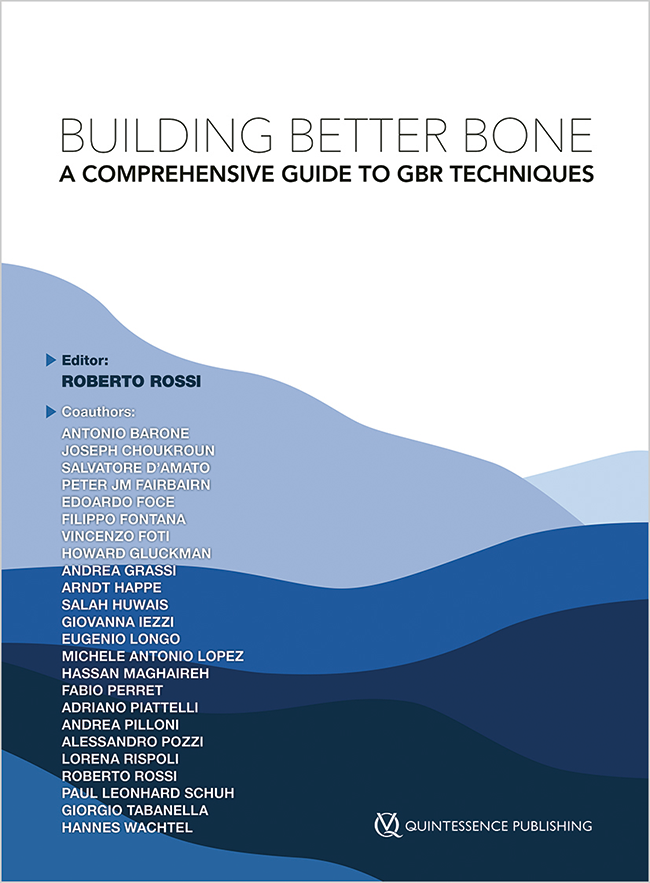QZ - Quintessenz Zahntechnik, 12/2024
ErfahrungsberichtSeiten: 1214-1229, Sprache: DeutschBertazzo, Davide / Conti, Alessandro / Rossi, RobertoTotalrekonstruktion eines stark atrophierten OberkiefersDie prothetische Versorgung zahnloser Kiefer mit verschraubten Totalrekonstruktionen gilt heute als valide Rehabilitationstherapie, mit der sich Patienten, die früher herausnehmbar hätten versorgt werden müssen, angemessen funktionell und ästhetisch rekonstruieren lassen. Dieser Erfolg wird jedoch stark von der klinischen und technischen Planung beeinflusst. In diesem Beitrag werden die für diese Art der Rehabilitation am besten geeignetsten Materialien untersucht und es wird aufgezeigt, wie durch deren sinnvolle Kombination die ästhetische Reproduzierbarkeit vereinfacht und die Versorgung erschwinglicher werden kann.
Schlagwörter: Implantatästhetik, Implantatprothetik, Totalrekonstruktion, Kieferkammatrophie, Lithiumdisilikat
International Journal of Esthetic Dentistry (DE), 3/2022
Clinical ResearchSeiten: 266-278, Sprache: DeutschLongo, Eugenio / de Giovanni, Francesco / Napolitano, Francesco / Rossi, RobertoIn der täglichen Praxis ist die Verwendung digitaler Operationsschablonen üblich geworden. DVT, digitale Abformungen und stereolithografische Modelle sind die entscheidenden Hilfsmittel für die Herstellung solcher Schablonen, die bei der chirurgischen Planung und Behandlung verwendet werden. Mittlerweile kommen in der Parodontalchirurgie insbesondere zur Behandlung eines unvollständigen passiven Zahndurchbruchs vermehrt digital konstruierte Schablonen zum Einsatz. Solche individuellen digitalen Schablonen können die Sicherheit, Genauigkeit und Vorhersagbarkeit der chirurgischen Kronenverlängerung bei Patienten mit unvollständigem passivem Zahndurchbruch und hohen ästhetischen Ansprüchen verbessern. Während bei den meisten in der Fachliteratur vorgeschlagenen Ansätzen Schablonen für die Primärinzision und Gingivektomie verwendet werden, können sie auch für eine erhöhte Präzision der Ostektomie und Osteoplastik eingesetzt werden, womit sie eine Schlüsselrolle für das Rückwachstum des Weichgewebes und damit das ästhetische Endergebnis einnehmen. Im vorliegenden Artikel wird ein neuer Ansatz für die Hart- und Weichgewebekorrektur bei unvollständigem passivem Zahndurchbruch gezeigt, bei dem zwei separate Schablonen verwendet werden.
International Journal of Esthetic Dentistry (EN), 3/2022
Clinical ResearchPubMed-ID: 36047884Seiten: 254-265, Sprache: EnglischLongo, Eugenio / de Giovanni, Francesco / Napolitano, Francesco / Rossi, RobertoDigital guides (also known as stents) have become commonly used in daily dental practice. CBCT, digital impressions, and stereolithographic models are considered extremely helpful to create guides for the planning and resolution of surgical cases. In recent years, in periodontal surgery and in particular for the treatment of altered passive eruption (APE), there has been an increasing use of digitally designed guides to improve esthetic outcomes and achieve more predictable results. Digital custom-made guides can be used to improve safety and precision in crown lengthening procedures in patients with APE who have high esthetic expectations. Although most approaches described in the literature show guides used for primary flap or gingivectomy design, the precision of bone recontouring and ostectomy plays a key role in soft tissue rebound and in the final esthetic outcome. The present article describes a new approach using two different guides for soft tissue design in patients with APE.
International Journal of Esthetic Dentistry (EN), 3/2021
PubMed-ID: 34319669Seiten: 350-363, Sprache: EnglischCozzani, Mauro / Rossi, Roberto / Antonini, Salima / Raffaini, MircoA smile is a symbol of beauty and wellbeing in our modern society, human facial expression transcending language, culture, race, gender, time, and socioeconomic differences. An esthetic smile consists of three main components: the teeth, the lip framework, and the gingival scaffold. In some patients, the altered relationship between the teeth, the alveolar bone, and the soft tissue may result in the clinical condition known as gummy smile. A single factor or a combination of factors may be present in patients with this clinical condition, including altered passive eruption (APE), vertical maxillary excess, and a short or hyperactive upper lip. The present article reports on a 31-year-old female patient who presented for a consultation. The patient, who was in good general health with no significant medical history, was dissatisfied with her tooth esthetics. She had symmetric facial features with a long face appearance, retruded chin, protruded maxillary incisors, and excessive gingival display that indicated evident APE. In particular, the present case report aims to describe a multidisciplinary treatment involving a phase of orthodontics associated with maxillofacial surgery, and the periodontal surgical sequence of esthetic crown lengthening for the treatment of APE.
International Journal of Esthetic Dentistry (DE), 3/2021
Seiten: 374-388, Sprache: DeutschCozzani, Mauro / Rossi, Roberto / Antonini, Salima / Raffaini, MircoIn der heutigen Gesellschaft steht das Lächeln für Schönheit und Wohlergehen. Es ist ein menschlicher Gesichtsausdruck, der jenseits von Sprache, Kultur, ethnischer Zugehörigkeit, Geschlecht, Zeitalter und sozio-ökonomischen Unterschieden besteht. Ein ästhetisches Lächeln setzt sich aus drei Hauptkomponenten zusammen: den Zähnen, dem Rahmen durch die Lippen und dem gingivalen Gerüst. Bei manchen Patienten führt eine gestörte Beziehung zwischen den Zähnen, dem Alveolarknochen und dem Weichgewebe zu einer klinischen Situation, die als Gummy Smile (Zahnfleischlächeln) bezeichnet wird. Dies kann durch eine einzelne oder mehrere Ursachen bedingt sein wie unvollständigem passivem Zahndurchbruch, übermäßigem vertikalem Oberkieferwachstum und einer verkürzten oder hypermobilen Oberlippe. Der vorliegende Artikel zeigt den Fall einer 31-jährigen Patientin, die mit ihrer dentalen Ästhetik unzufrieden war und sich zunächst zur Beratung vorstellte. Sie war allgemein gesund und ihre medizinische Anamnese war unauffällig. Ihr Gesicht war symmetrisch mit dolichofazialem Erscheinungsbild, sie hatte ein fliehendes Kinn, protrudierende Oberkiefer-Schneidezähne und übermäßig sichtbare Gingiva, was offenbar auf einen unvollständigen passiven Zahndurchbruch zurückzuführen war. Im hier vorliegenden Fallbericht wird vor allem die multidisziplinäre Behandlung beschrieben. Sie umfasste eine kombinierte kieferorthopädische und kieferchirurgische Therapie sowie eine parodontalchirurgische Behandlung mit ästhetischer Kronenverlängerung zur Korrektur des unvollständigen passiven Durchbruchs.
International Journal of Esthetic Dentistry (DE), 4/2020
Seiten: 484-503, Sprache: DeutschRossi, Roberto / Ghezzi, Carlo / Tomecek, MartinKammdefekte treten nach Extraktionen sehr häufig auf. Aktuelle Veröffentlichungen zeigen, dass im Prozess der Knochen- und Weichgeweberemodellierung bis zu 50 % des ursprünglichen Volumens verloren gehen kann. Über die Jahre wurden verschiedenste chirurgische Ansätze für die Korrektur von Kammdefekten vorgeschlagen, aber die Ergebnisse waren häufig inkonsistent oder im Praxisalltag schwer zu reproduzieren. Seit einiger Zeit verlassen sich Oralchirurgen auf die Technik der gesteuerten Knochenregeneration (GBR). Hierbei wird eine Barrieremembran genutzt, um das Koagulum zu schützen, sowie Mischtransplantate aus autogenem Knochen und Knochenersatzmaterialien anderer Herkunft. Während jedoch für die Behandlung horizontaler Defekte eine Reihe von Erkenntnisse vorhanden und Richtlinien etabliert sind, gelten dreidimensionale und vertikale Defekte weiterhin als erhebliche Herausforderung. Seit etwa einem Jahrzehnt ist ein neues Biomaterial am Markt verfügbar: Für eine dünn geschliffene, kollagenhaltige kortikale Knochenlamelle, die auch als kortikale Lamina bezeichnet wird, hat sich erwiesen, dass sie bei der Korrektur horizontaler und vertikaler Defekte gut zu verarbeiten ist. Ziel dieses Artikels ist ein Review der aktuellen Literatur zu diesem Thema. Außerdem sollen anhand von drei Patientenfällen mit unterschiedlicher Komplexität drei Varianten des Materials mit seinen spezifischen Indikationen und Eigenschaften diskutiert werden.
International Journal of Esthetic Dentistry (EN), 4/2020
PubMed-ID: 33089260Seiten: 454-473, Sprache: EnglischRossi, Roberto / Ghezzi, Carlo / Tomecek, MartinRidge defects are a very common finding after tooth extraction. Recent literature has shown that the pattern of bone and soft tissue remodeling can obtain up to 50% of the original volume. Many different surgical approaches have been proposed over the years to correct ridge defects, but the results have often been inconsistent or difficult to reproduce on a daily basis. For some time, surgeons have relied on the guided bone regeneration (GBR) technique, taking advantage of a barrier membrane to protect the blood clot, combined with different combinations of autogenous bone and bone grafts from various sources. If some kind of understanding has been reached and certain guidelines adopted for the treatment of horizontal defects, those for tridimensional and vertical defects still present a challenge. About a decade ago, a new biomaterial became available on the market – a membrane made of collagenated porcine bone called cortical lamina – which proved to be reliable and easy to handle for both horizontal and vertical defects. The aim of this article is to review the current literature on the topic and to discuss the material in its three forms through the presentation of three patient cases of differing complexity, each with its unique indications and characteristics.
The International Journal of Oral & Maxillofacial Implants, 4/2018
DOI: 10.11607/jomi.6509, PubMed-ID: 30025009Seiten: 913-918, Sprache: EnglischGatti, Claudio / Gatti, Fulvio / Silvestri, Maurizio / Mintrone, Francesco / Rossi, Roberto / Tridondani, Gabriele / Piacentini, Giacomo / Borrelli, PaolaPurpose: To compare the peri-implant radiographic crestal bone changes around implants placed at the subcrestal or crestal level.
Materials and Methods: Systemically healthy patients with at least two missing teeth requiring implant-supported fixed prosthetic restorations were enrolled in the study. Implants were randomly placed either 1 mm subcrestally or at the bone crest level. Radiographic examination was performed using the long-cone parallel technique and customized film holders. Digital periapical radiographs were obtained at the time of implant placement (T0), at the time of prosthesis delivery (T1), and 12 months (T2) after prosthetic loading. Marginal bone levels were measured at the mesial and distal aspects of each implant with digital image software.
Results: A total of 54 implants were present for the radiographic analysis at the 12-month follow-up. No implant showed mechanical or biologic complications throughout the follow-up period. The implant survival percentage was 100%. After 1 year, the mean bone loss was 0.711 ± 0.721 mm in the subcrestal group and 0.224 ± 0.418 mm in the crestal group. Furthermore, only the subcrestal group showed statistically significant radiographic bone resorption at the end of the follow-up.
Conclusion: Within the limitations of this study, implants placed at the crestal level showed greater peri-implant bone stability during the 1-year follow-up. Studies with larger samples and longer follow-up are needed to confirm the results of this investigation.
Schlagwörter: bone preservation, crestal bone level, dental implants, surgery
QZ - Quintessenz Zahntechnik, 7/2016
Exzellente Dentale ÄsthetikSeiten: 905-906, Sprache: DeutschBertazzo, Davide / Conti, Alessandro / Rossi, RobertoInternational Journal of Oral Implantology, 3/2015
PubMed-ID: 26355168Seiten: 233-244, Sprache: EnglischEsposito, Marco / Grusovin, Maria Gabriella / Lambert, France / Matos, Sérgio / Pietruska, Małgorzata / Rossi, Roberto / Salhi, Leila / Buti, JacopoPurpose: To evaluate the effectiveness of a bone substitute covered with a resorbable membrane versus open flap debridement for the treatment of periodontal infrabony defects.
Materials and methods: Ninety-seven patients with one infrabony defect, which was 3 mm or deeper and at least 2 mm wide were randomly allocated either to grafting with a bone substitute covered with a resorbable barrier (BG group) or open flap debridement (OFD group) according to a parallel group design in five European centres. Blinded outcome measures assessed tooth loss, complications, patient's satisfaction with treatment and aesthetics, changes in probing attachment levels (PAL), probing pocket depths (PPD), gingival recessions (REC), radiographic bone levels (RAD) on standardised periapical radiographs, plaque index (PI) and marginal bleeding index (MBI).
Results: 49 patients were randomly allocated to the BG group and 48 to the OFD group. At baseline there were more mobile teeth in the BG group (29 versus 15). One year after treatment two patients dropped out from the BG group and no teeth were lost. Three complications (minor postoperative wound dehiscence) occurred in the BG group versus none in the OFD group, where the difference was not statistically significant. The BG group obtained significantly greater statistical PAL gain (mean difference = -0.8 mm, 95%CI [-1.51; -0.03], P = 0.0428), PPD reduction (mean difference = -1.1 mm, 95%CI [-1.84; -0.19], P = 0.0165) and RAD gain (mean difference = -1.2 mm, 95%CI [-2.0; -0.4], P = 0.0058) compared to the OFD group. No statistically significant differences between the groups were observed for gingival recession, or the patient's satisfaction with the treatment and aesthetics. There were some statistically significant differences between the centres for PAL and PPD with the Italian centres reporting better outcomes.
Conclusions: The use of a bone substitute covered with a resorbable membrane yielded significantly better statistical clinical outcomes than open flap debridement in the treatment of periodontal infrabony defects deeper than 3 mm, with regard to PAL gain, PPD reduction and RAD gain.
Schlagwörter: bone substitutes, infrabony defect, periodontitis, randomised controlled trial




